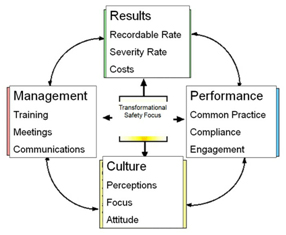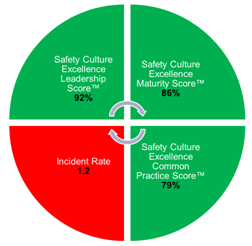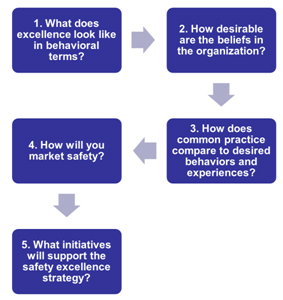POWER Magazine - August 2012
By: Shawn M. Galloway
Printable Version
It is a new month. I want you all to work very hard to fail less than previous months. I'll be measuring. Failures will not be tolerated. Anyone caught doing so will be disciplined by their peers and/or leadership.
Leading and measuring with the aforementioned approach creates malicious compliance, avoidance behavior, a have-to mentality and disdain toward the organization. Teamwork becomes a pointless buzzword and fear of measurement sets in. When organizations measure only incidents and establish and reward incident reduction goals, "fail less" becomes the message. Are your safety measurement systems focusing on motivation and excitement, or evaluation and reactive accountability?
Lagging Indicators Create Hope
Incident metrics are prescriptive when there is a lot of data. As safety improves, the data used to advance results loses statistical significance which leads to a multitude of random data points. As an organization matures in their safety management systems and culture, injury data moves from prescriptive to descriptive, then to demotivating and borderline pointless. When you achieve zero incidents, how do you continue to improve? Most importantly, are the results due to purposeful initiatives and accountability, or luck? What sense of comfort does the organization have that results will repeat next year?
An injury or incident is a failure in your prevention process.. When the strategy or measurements are focusing on reducing injuries, the culture is being motivated to avoid failure rather than achieve success.
When a failure occurs and tactics are deployed quickly to prevent recurrence, there is an impression that "leadership is reactive when it comes to safety" or, "someone has to get hurt for safety to improve." Rarely are high-performing cultures motivated by measurement of such an approach.
Measurement: Motivational or Demotivating?
Measurement is supposed to direct, align and motivate behavior. What percent of the population in your organization is motivated, or even excited, by safety measurement compared to those who are fearful of it?
Executives deploy a multitude of measurement systems to validate the health of operations. Safety is no different than any other operational priority, yet few leverage balanced scorecards or transformational measurement dashboards. If safety is such an important priority or core value, how balanced and comparative are the average measurements? Figures 1 shows a sample balanced scorecard. Figure 2 shows a sample transformational measurement dashboard.

Figure 1: Balanced Scorecard for Safety Excellence

Figure 2: Transformational Safety Measurement Dashboard
Of course, measuring results is important; ignoring this will be career-limiting. However, results alone do not identify what actions must be taken to continue achieving them. Approach a sampling of employees, tell them what the current incident rate is, and ask what they can do to impact it. How aligned are the responses with the reality of what the focus needs to be? Further, ask employees if they know how the incident rate is calculated. Unfortunately, the average reader will be disappointed by the answers they receive.
Key Questions to Identify Leading and Transformational Measurements
Working with many of the best safety-performing organizations in the industry, I have created leading, comparative indicators and overall transformational balanced scorecard safety measurement systems. Consider collaborating with other leaders and influential followers in your organization to answer the following questions. The answers to such questions can facilitate the transformation necessary for obtaining breakthrough performance.
- What does excellence look like in behavioral terms? What would you see or hear the average employee, supervisor, manager or executive doing or saying that creates a sense of comfort that success is near, because you are effectively working your plan and executing against your strategy? If safety excellence is defined in behavioral terms (what people need to do to create the results), it is observable. If it is observable, feedback is possible. When this happens, the organization is effectively coaching for performance, rather than managing results through a trial-and-error strategy.
- How desirable are the beliefs in the organization? Beliefs influence decisions, behaviors and stories told throughout the organization. Desirable perceptions are a common leading indicator opportunity in the industry and measuring those through a perception survey is easier than many realize. What would the desirable perceptions be and what is the current gap?
- How does common practice compare to desired behaviors and experiences? What is the reality of the day-to-day activities compared to what is desired?
- How will you market safety? Yes, market safety. Often ignored, significant value is derived by focusing on branding, positioning, voice of the customer and reinforcing the buying decisions. How will measurement systems solicit discretional effort?
- What initiatives will support the safety excellence strategy? This should be the last question of this series. Unfortunately, the average organization deploys many great attempts to improve safety, but has difficulty demonstrating how the attempt will produce measurable progress. New initiatives need to demonstrate a measurable improvement in beliefs, decisions, behaviors and stories; not just results.

Figure 3: Questions for Developing Leading & Transformational Measurements
Delegate Priorities, Not Values
For safety to become a core value, safety improvement cannot be delegated. Values are created when, over time, beliefs are reinforced by consistent behaviors, at or near the point of decision. This requires key decision makers to be involved in the creation and continuous evolution of the measurement strategy. Measuring the right things and celebrating leading indicator progress is far too important to be the sole responsibility of the safety department if sustainable excellence is your goal. Unless, of course, you are okay with just failing a little less year after year.

Shawn Galloway, CEO of ProAct Safety, is an expert in safety excellence. With almost thirty years of experience, he is a highly sought-after advisor, keynote speaker, and expert witness. Shawn has become a trusted partner to leading organizations across various industries worldwide. He ranks in the top 1% of the most prolific writers in his field, having authored over 500 articles and several bestselling books. He also launched the world's first safety podcast, Safety Culture Excellence©. As a recognized authority in safety, Shawn has received awards such as being named among the Top 50 People Who Most Influence EHS and a Top 10 Speaker, among others.
He is a regular guest on Bloomberg, Fox News, The Daily Mail, Dubai One, U.S. News & World Report, Sirius Business Radio, Wharton Business Daily, and leading safety magazines and podcasts. Shawn also serves as a member of the Harvard Business Review Advisory Council, Forbes Business Council, and Fast Company Executive Board, enabling his influence to shape safety thinking and strategy at the executive level.
